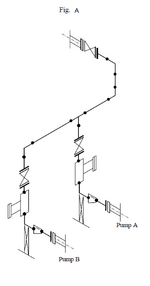So i was reading about this topic and I found this
"Figure “A” below shows an ideal configuration of piping, in which the piping distance between each nozzle is minimized. In the case of hot oil piping, differences in expansion occur between the suction piping of pump A and that of pump B, according to the operating conditions of these pumps (pump A: operated, pump B: not operated). This poses problems with thermal stress analysis or causes dust and the like, which accumulates within the piping system, to center on Pump A strainer, which therefore is likely to plug. This configuration, therefore, is not employed for piping handling high-temperature fluids or fluids which are likely to cause plugging (tower bottom, sludge line, etc.)."
so the question is : what should be the arrangement when the fluid is a high temperature fluid??And why will the strainer be plugged in that case??
"Figure “A” below shows an ideal configuration of piping, in which the piping distance between each nozzle is minimized. In the case of hot oil piping, differences in expansion occur between the suction piping of pump A and that of pump B, according to the operating conditions of these pumps (pump A: operated, pump B: not operated). This poses problems with thermal stress analysis or causes dust and the like, which accumulates within the piping system, to center on Pump A strainer, which therefore is likely to plug. This configuration, therefore, is not employed for piping handling high-temperature fluids or fluids which are likely to cause plugging (tower bottom, sludge line, etc.)."
so the question is : what should be the arrangement when the fluid is a high temperature fluid??And why will the strainer be plugged in that case??

